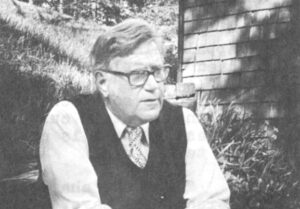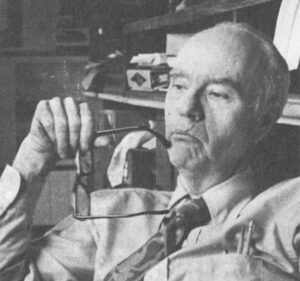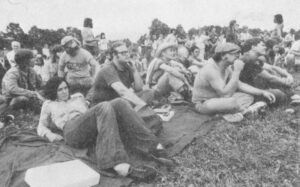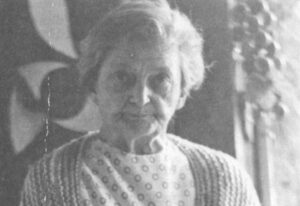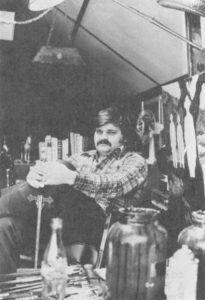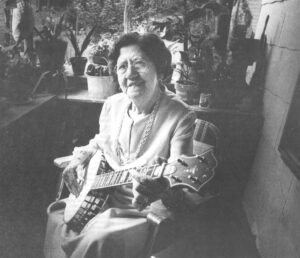James Domengeaux, an aging Lafayette attorney, pounded the cluttered desk in his office a stone’s throw from one of Louisiana’s most impressive cathedrals.
“Dammit. It’s a wonder we’re not all warped,” he spat. “After all, we’re just coming from a time when there were certain punitive, abrasive actions taken when one spoke the French language. We became ashamed to speak French. You couldn’t help but feel ashamed, especially if you were young and immature and were told you were going to have to stay after school because you spoke French. Or maybe the teacher would hit you on the head with a ruler. We were told that only poor people and ignorant people spoke French. Can you believe that?”
Though his hair is gray and his body shows the marks of 66 long, hard years of labor, Domengeaux still bristles like a young tomcat at the thought of what has happened to his native tongue.
Domengeaux (pronounced Doe-mawn-joe) is a native of Lafayette and calls himself a Cajun. He was reared speaking the French language. But, he saw the language almost disappear before he decided to do something about preserving it.
Today, Domengeaux is being called the French equivalent of Huey Long, a charismatic personality on whom hinges the hope for bilingualism in Louisiana, and, perhaps, the survival of the Cajun folk culture.
But the experiment being conducted by Domengeaux and his Council for the Development of French in Louisiana (CODOFIL) is filled with pitfalls. His methods are untested and could result in the eradication of one of America’s last remaining folk cultures.
“CODOFIL will either cure the Cajun culture or kill it,” one observer said. “Domengeaux and his crowd will either destroy the local French language or they’ll bring a solidarity among the Cajuns not known for a hundred years. But, at least he’s doing something, even if it’s wrong.”
Domengeaux is not directly concerned about preserving the distinctive Cajun culture. “Preserve the language and you’ll preserve the culture,” the fiery old politician says. “Language is one of the tangibles, perhaps the only tangible, of the Cajun culture. It’s the only one that can be taught in school, anyway. And that’s what I’m after — teaching every child in the State of Louisiana to be bilingual.”
There’s no denying that the French language has been the glue that has held the Cajun folk culture together for 200 years. Sociologists say language makes a member of a folk culture easily identifiable to others in the culture. The language brings a feeling of solidarity, especially if it’s different from the prevailing cultures. It tends to strengthen traditions and customs that are apart from the mainstream.
That’s been the case with the Cajuns of southern Louisiana. When the exiled Acadians first settled in the bayou country south and west of New Orleans in the latter half of the 18th Century, they brought the French language with them. Separated from New Orleans by wilderness swamps and from mainstream America by sparsely settled lands to the north and west, the language of their ancestors became the predominant method of communicating.
Even the later immigrants into Cajun country gave up their ancestral languages in favor of the dominant French language. For example, the large number of Germans had little impact on the language and today, throughout the 21 parishes of “Acadiana,” people with German names can be heard speaking French. The same holds true for those with Irish, English and Eastern European ancestries. The dominant French gene in the Cajun culture prevailed with a few exceptions. One of them was the introduction of a different form of French by the blacks who settled here both before and after the Civil War. They brought a language known locally as “French Creole.”
Dorice Tentchoff, a cultural anthropologist who has done numerous studies on Cajun communities, says the French Creole language has very different origins from Cajun French. According to Ms. Tentchoff, French Creole developed during the 17th Century in the course of contact between French-speaking Europeans and Africans, both on the west coast of Africa and in the French colonies of the New World. French Creole became the native language of many Africans on both sides of the Atlantic as well as on the islands in the Indian Ocean.
In addition to the two basic forms of French above noted, the years of isolation coupled with the close relationships between blacks and whites in the island-like cultural vacuum produced mixtures of the two languages. Thus, in one Cajun village, says Ms. Tentchoff, a simple phrase such as “I have to go now,” might be said four ways:
J’ai pour aller asteur.
I faut je va asteur.
Mo gain pou couri asteur.
I faut mo va asteur.
In addition, says Ms. Tentchoff, an intricate system of social values has been placed on how a person speaks French, or more precisely, how he selects his linguistic forms. These “markers,” she says, distinguish Creole from Cajun French.
All of this apparently occurred before the English language began to make significant inroads. By the beginning of the 20th Century, however, Louisiana state politics were under the control of the people from north Louisiana. These people were of Scotch-Irish ancestry and had a strong folk culture all their own. They were akin to the people of the Appalachian mountains as well as the cowboys of the West.
The Scotch-Irish took power politics seriously and may have seen the French-speaking people in south Louisiana as a “foreign threat.” For whatever reason, the total weight of the state’s educational system was brought to bear on the French-speakers in the south. Just as the British had tried to eradicate the French culture in Nova Scotia in the mid-18th Century, the Scotch-Irish state leaders apparently decided to weaken the tight-knit Cajun culture that was held together by language.
Cajuns recount endless stories of how they were prohibited from using French on public school grounds. Apparently the educators used the excuse that the French being spoken in the Cajun homes was an illiterate French. In fact, few of the hundreds of thousands of French-speakers could either read or write the language. The same is true today.
The reason state and parish school systems decided not to build on the French language tradition is not known. Perhaps they decided there was no future in Americans learning to speak a second language. Perhaps they felt they did not have the resources to deal with bilingual education. Perhaps, because of the extremely high rate of illiteracy in Louisiana, they decided their major missionary effort should be directed toward teaching the English language.
In any event, the negative reaction to French in the public education system had its effect, but not the total effect many desired. Students generally held to the no-French rule while on the school grounds, but once home, they returned to their native French tongue as the method of communication. Thus, English became a second, learned language to them, a “foreign” tongue.
The public school boards may have been no match for the Cajun culture, but mainstream America was. Apparently, about the time of Roosevelt’s New Deal, when education and adherence to mainstream American ideas and attitudes were first considered necessary to success, Cajun parents decided teaching Cajun French to their children was harmful if their children were expected to “get by” in modern America.
Thus nearly all Cajuns gave up speaking any form of French in their homes. These French-speaking parents indicate it was an almost subliminal act.
Yet French continued to be a major part of the Cajun lifestyle. The 1970 Census showed, for example, that of the 21 parishes considered part of Acadiana, about 45 per cent of the people called French their mother tongue. In St. Martin Parish, for example, 79.1 per cent of the 32,453 inhabitants considered French their mother tongue. Even in the urban parish of Lafayette, 52.1 per cent of the 109,716 residents were French-speakers.
Thus it was clear the French language was giving up, but not without a fight. What seemed to put the language in most peril was that the large proportion of French-speakers were from the older generation. The younger people simply weren’t learning the language of their forebears. Cajun French wasn’t being spoken in the homes nor being taught in the schools.
Several years before the 1970 Census report was published, Domengeaux and his colleagues had identified the problem as they saw it.
Domengeaux, a former member of the Louisiana Legislature, said he made several speeches on the floor of the Louisiana House of Representatives about the threat of losing the French language as early as 1940. He says he even made note of the problem on the floor of the U.S. House of Representatives while serving three terms from his home district in the 1940s.
“But in those days, I wasn’t committed,” he says with a twinkle in his eye. “I guess I was more interested in women, booze and poker.”
Today, that’s all different. In facts he says, it all changed in 1967 when it became clear to him that something had to be done immediately to preserve the French language. There wasn’t time for consultants and debates about how to approach the problem. Every year meant a declining number of French-speakers in his native region.
From his concern came the Council for the Development of French in Louisiana. He began by preaching to anyone who would hear. From Monroe in the north to New Orleans in the south he sounded the warnings: southern Louisiana, a region once populated by nearly 100 per cent French-speakers, was about to lose its native language. English was moving in on the old language and overwhelming it at an astonishing rate.
“I believe the melting pot philosophy has served its purpose in America,” Domengeaux says. “I believe that, in this highly competitive world, the necessity of a nation such as ours speaking more than one language is tantamount to our ability to meet the demands of a diminishing world. All of us In CODOFIL recognize this great linguistic and cultural opportunity that we have here in Louisiana.”
Domengeaux was quick to get minimal funding for CODOFIL from the state government in 1968. His knowledge of old-time Louisiana politics apparently helped him in obtaining the money.
One of his first moves as executive director of CODOFIL was to find a few school boards sympathetic to his cause. In 1970, he found 30 teachers in France who were willing to come to Louisiana to teach French in a region starved for foreign language teachers.
Some of these teachers called Louisiana’s local French “very good 17th Century French,” not at all unusual when it’s remembered that the Cajuns were cut off from everyone, including the mother country, once they settled in Louisiana.
Prior to the arrival of the French teachers, Domengeaux had managed to push an act through the state legislature requiring French to be taught in the first five elementary grades and the three high school grades of every public school by 1972-73. There was a catch, however. If a school board decided not to offer French courses, it simply had to give some sort of explanation. Nearly any explanation would suffice.
Most school boards opted for no French, apparently a holdover from old attitudes about the language. But that didn’t stop Domengeaux and CODOFIL. The program to develop French in Louisiana took on new significance when the first Cajun governor in more than a hundred years, Edwin Edwards, ran a successful race in 1971.
For the first time in anyone’s memory, a successful statewide candidate won in an appeal for all Cajuns to vote as a block. Ands vote they did. It is estimated that nearly 90 per cent of the Cajuns cast their votes for Edwards, who used “Cajun Power” as his slogan and a fist clenched around a crawfish as his battle insignia.
The number of imported French teachers continued to increase. This year, nearly 300 French teachers from France, Belgium, Quebec, Switzerland and Haiti are scattered throughout Louisiana, teaching conversational French.
“For the first time in years, children are speaking in French with their grandparents, since the middle generation missed out entirely on the French language,” one newspaper commentator noted.
Thus, the irony of an educational system attempting to suppress bilingualism is being turned around. Even the French and Canadian governments are becoming excited about the French program in Louisiana. Both have given money to CODOFIL. Hundreds of visitors from France and Quebec make pilgrimages to Louisiana. Most are greeted and given the official tour by Domengeaux.
In return, honors came to Domengeaux last summer when Jacques Kosciusko-Morizet, the French ambassador to the United States, presented the CODOFIL chief executive with France’s highest honor — the Cross of Officer In the National Order of the Legion of Honor. The Legion was created during the time of Napoleon Bonaparte and few are awarded the distinction outside of France.
But Domengeaux is not so excited about the personal honors as he is about a new act of the Louisiana Legislature. The controversial act decrees that if 25 per cent of the parents in a given school district designate they want French, or a second language, taught in the school, it is the duty of the school board to put French, or the second language, in the school.
“Furthermore, it must be done in a well-articulated and sequential manner so as to give the students a good background in the language,” Domengeaux says.
“You may not believe it, but our biggest problems come from the school boards and governing authorities of this region. They’re all Cajuns, all French-speakers, but they resist French being taught in the schools. That’s a disgrace and a dishonor and they detest me for the program. But there’s a reason for it. The average French-speaking schoolteacher-educator-administrator-superintendent is the victim of the time when our French language was associated with poverty and ignorance. They haven’t overcome that yet. They are stagnated people, interested in their eventual retirement and increased salaries. They don’t want to rock the boat.”
Domengeaux says CODOFIL receives considerable support from the school districts in the English-speaking north where several CODOFIL teachers are located. Apparently the attitudes about bilingualism have changed in the Scotch-Irish culture where the value of bilingualism has been noted and where the stigma of being a French speaker never existed.
But in the south, all but the upper echelon educators continue to fight and complain about CODOFIL. A number of teachers’ groups have complained about CODOFIL’s importing foreign teachers for the purpose of teaching French. As a result, a method has been established for preparing Louisiana teachers to teach French. But the program hasn’t been funded. Domengeaux sees this as another roadblock spawned by middle-level bureaucrats in the educational system.
Whether or not Domengeaux is successful in transforming every graduate of Louisiana’s school system into a bilingual whiz kid, it’s clear he and his CODOFIL program have had a significant impact on the Cajun culture.
Perhaps more than any other man, Domengeaux has helped identify the Cajun culture for the Cajuns. He doesn’t blame the English-speakers for eradicating French. “We’re the ones to blame because we’re the ones who stopped using it.” Nearly every older Cajun agrees. They blame no one but themselves.
Domengeaux has given the Cajun culture new status by inviting scores of French scholars, government officials, journalists and tourists to Cajun country. Invariably these visitors praise the Cajuns for their knowledge of the French language and the delight the visitors have in finding a French-speaking colony in the United States. That these knowledgeable and educated people, who speak what the Cajuns call “pretty French,” have a high regard for the Cajuns seems to erase the past degradations by mainstream America and its English-speaking majority.
Domengeaux is quick to lash out at those who fortify the stereotyped image of the Cajun. “Good Times Are A-Killing Me,” a recent one-hour television special, funded in part by the Public Broadcasting System, incurred his wrath because he said it tended to portray all Cajuns as illiterate alcoholics. He wrote scores of letters to his friends in Congress, asking for a federal investigation of PBS as a result of the special program.
Mention Cajun humor to Domengeaux and it puts him in yet another orbit. Domengeaux says the current round of Cajun jokes, similar to other slanderous ethnic jokes, is not Cajun humor, but rather humor invented by other cultures to make fun of the Cajuns.
But for all this, Domengeaux has his critics. And some of those critics make a great deal of sense. Perhaps the strongest argument against CODOFIL is summed up in a letter published recently by the Lafayette newspaper, The Daily Advertiser. The writer, Richard C. Landry, notes the recent movement to preserve the French language and the dying French-Acadian culture. Landry wrote:
“It seems that the prevalent opinion as to how to achieve this restoration is that of flooding the classroom with teaching of actual native French from across the sea by actual Frenchmen and the mass media type exposure of local celebrities encouraging the use of French in everyday activities…The French Acadian heritage will not be handed down through the ages by exposing school children to the Parisian French language in a classroom atmosphere nor will it be handed down by a few people telling the public, through newspapers and television, that speaking French is the ‘in’ thing.”
“A heritage is handed down by normal, everyday interaction between parents and children and friends and neighbors, in a natural setting where pride for a common land and language keep the heritage alive.”
Domengeaux is aware of the criticism. He’s also aware of the differences between Cajun French and Parisian French. Likewise, he’s aware that Cajun French is spoken somewhat differently in Breaux Bridge than it is in St. Martinville, fewer than 50 miles away. Domengeaux says, however, these differences are superficial.
“I’m not sure there are basic differences. After all, I don’t know many people who speak the English of Churchill, but it’s English all the same. I think there is more uniformity of language here in Louisiana than there is in France,” he says.
“There have been charges that we’re trying to smother the Cajun language. That’s a bunch of bull. There will be certain evolutionary processes. French may go back to where it was 80 years ago when we spoke a pretty good French. I think the French has deteriorated through non-use and a limited vocabulary.”
Domengeaux says he’d try to save the local flavor of French if he could. But, in fact, there seems to be no way. There’s no published dictionary for Cajun French or French Creole. There’s been no systematic study of linguistics in southern Louisiana. Those familiar with language say there seem to be French language systems in the region, but they have not been identified and catalogued to any great extent.
“I don’t know what to do about it. I know that if you don’t get French in the schools, it’s going to be lost,” Domengeaux says. “So, we have brought in people from Belgium, Canada and France to teach French. What comes out of it? I don’t know. Perhaps it’s not going to be the same accent we speak now. I can assure you that there’s no effort other than to give French a permanency and hope for survival.”
Under the program outlined by CODOFIL, will the Cajun culture be revived, or will it simply be replaced by a style of French living found in Europe? Until CODOFIL, the French language was the language of illiteracy. Everyone spoke it but no one wrote it or read it. What effect will it have on the culture if everyone reads and writes French? Since Cajun French and French Creole do not have dictionaries, is there really any way to preserve them in a literate society?
These are questions that are bothering many people concerned with preserving the Cajun culture. But while they debate the issues, Domengeaux is the only one who has done anything, “even if it’s wrong.”
If there is a solution to the problem of how best to preserve the language and the culture, it won’t come easy. Perhaps it will come too late, long after the French in Louisiana is exactly like the French spoken on the streets of Paris.
Received in New York on December 10, 1975
©1975 Dave Peyton
Dave Peyton is an Alicia Patterson Foundation award winner on leave from The Huntington Advertiser (West Virginia). This article may be published with credit to Mr. Peyton, The Huntington Advertiser, and the Alicia Patterson Foundation.

